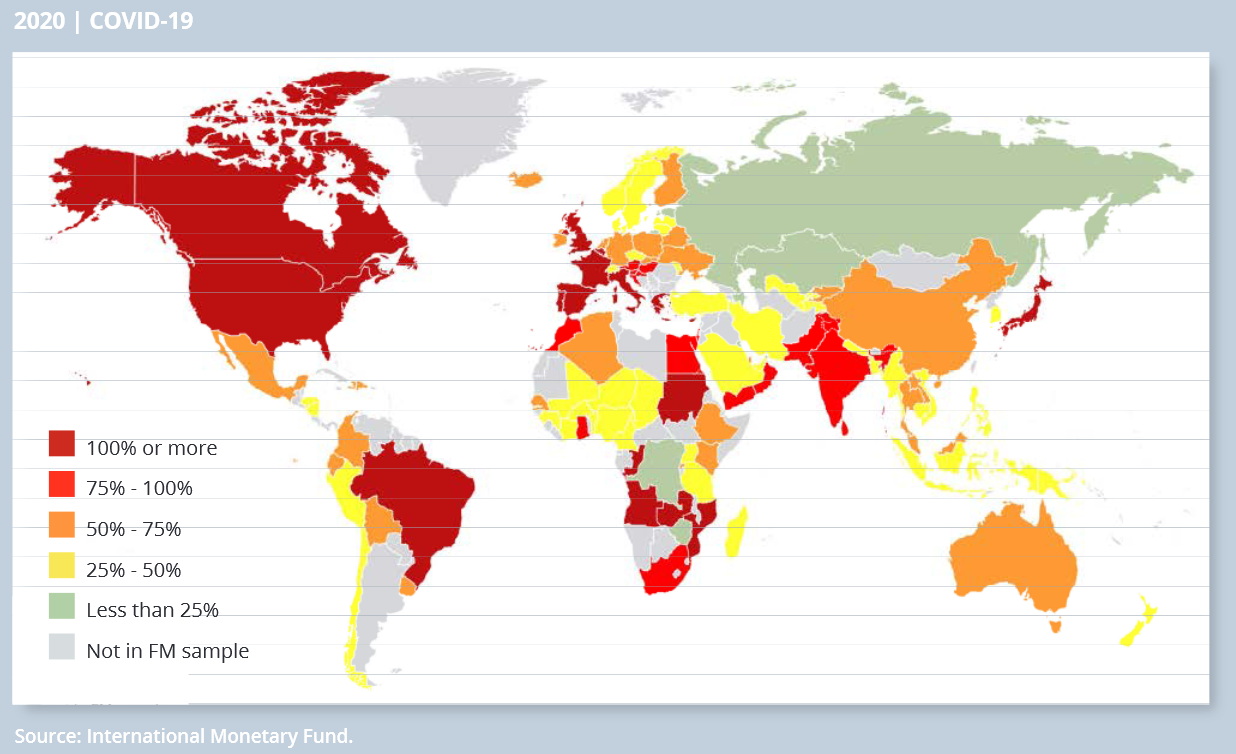Chapter 2 Structural Forces
“The peoples are not awake…[There are dangers] which will render a world organization impossible. I foresee the renewal of…the secret bargaining behind closed doors. Peoples will be as before, the sheep sent to the slaughterhouses or to the meadows as it pleases the shepherds. International institutions ought to be, as the national ones in democratic countries, established by the peoples and for the peoples.”
Henri La Fontaine, 1913
2.0.1 Agenda
Introduction
Definitions
Structural Forces
Conclusion
2.0.2 1. Introduction
This seminar is about understanding who builds scenarios for the future, and what are these scenarios right now.
Killing a president in Haïti, blocking the Suez Canal, Human rights violations, earthquakes… and the SARS-CoV-2 pandemic.
Do we have frameworks to design scenarios? What are the dimensions to consider?
Can we rely on our new tools and data?
Example: The Canadian Elections here
knitr::include_graphics("./images/img24.png")
Source: https://www.youtube.com/c/TheTrilateralCommission/videos
Nonstate actors:
Trilateral Commission
2.0.3 2. Definitions
Decision Science:
Certainty
Uncertainty
The area of choice under uncertainty represents the heart of decision theory.
Known from the 17th century (Blaise Pascal invoked it in his famous wager, which is contained in his Pensées, published in 1670), the idea of expected value is that, when faced with a number of actions, each of which could give rise to more than one possible outcome with different probabilities, the rational procedure is:
to identify all possible outcomes,
determine their values (positive or negative) and the probabilities that will result from each course of action,
and multiply the two to give an expected value, or the average expectation for an outcome; the action to be chosen should be the one that gives rise to the highest total expected value.
In 1738, Daniel Bernoulli published an influential paper entitled Exposition of a New Theory on the Measurement of Risk, in which he uses the St. Petersburg paradox to show that expected value theory must be normatively wrong.
He gives an example in which a Dutch merchant is trying to decide whether to insure a cargo being sent from Amsterdam to St Petersburg in winter.
In his solution, he defines a utility function and computes expected utility rather than expected financial value.
In the 20th century, interest was reignited by Abraham Wald’s 1939 paper[10] pointing out that the two central procedures of sampling-distribution-based statistical-theory, namely hypothesis testing and parameter estimation, are special cases of the general decision problem. Wald’s paper renewed and synthesized many concepts of statistical theory, including loss functions, risk functions, admissible decision rules, antecedent distributions, Bayesian procedures, and minimax procedures.
The phrase decision theory itself was used in 1950 by E. L. Lehmann.
The revival of subjective probability theory, from the work of Frank Ramsey, Bruno de Finetti, Leonard Savage and others, extended the scope of expected utility theory to situations where subjective probabilities can be used.
At the time, von Neumann and Morgenstern’s theory of expected utility proved that expected utility maximization followed from basic postulates about rational behavior.
The work of Maurice Allais and Daniel Ellsberg showed that human behavior has systematic and sometimes important departures from expected-utility maximization.
The prospect theory of Daniel Kahneman and Amos Tversky renewed the empirical study of economic behavior with less emphasis on rationality presuppositions. It describes a way by which people make decisions when all of the outcomes carry a risk.
Kahneman and Tversky found three regularities:
in actual human decision-making, “losses loom larger than gains”;
persons focus more on changes in their utility-states than they focus on absolute utilities;
and the estimation of subjective probabilities is severely biased by anchoring.
2.0.4 2. Definitions
What is intelligence?
https://www.dni.gov/index.php/what-we-do/what-is-intelligence
Three Mission Objectives refer to foundational intelligence missions the IC must accomplish, regardless of threat or topic:
- Strategic Intelligence — inform and enrich understanding of enduring national security issues;
- Anticipatory Intelligence — detect, identify, and warn of emerging issues and discontinuities;
- Current Operations — support ongoing actions and sensitive intelligence operations.Four Mission Objectives identify the primary topical missions the IC must accomplish:
- Cyber Intelligence — provide intelligence on cyber threats;
- Counterterrorism — understand and counter those involved in terrorism and related activities;
- Counterproliferation — counter the threat and proliferation of weapons of mass destruction;
- Counterintelligence — thwart efforts of foreign intelligence entities.knitr::include_graphics("https://www.dni.gov/files/ODNI/images/article_images/IC_elements.png")
Source: https://www.dni.gov/index.php/what-we-do/ic-budget
| Fiscal Year | NIP Budget Requested | NIP Budget Appropriated | MIP Budget Requested | MIP Budget Appropriated | Total Appropriated |
|---|---|---|---|---|---|
| 2022 | $62.3 | ||||
| 2021 | $61.9 | $23.1 | |||
| 2020 | $62.8 | $62.7 | $23.0 | $23.1 | $85.8 |
| 2019 | $59.9 | $60.2 | $21.2 | $21.5 | $81.7 |
| 2018 | $57.7 | $59.4 | $20.7 | $22.1 | $81.5 |
| 2017 | $54.9 | $54.6 | $18.5 | $18.4 | $73.0 |
| 2016 | $53.9 | $53.0 | $17.9 | $17.7 | $70.7 |
| 2015 | $50.4 | $50.3 | $16.6 | $16.5 | $66.8 |
| 2014 | $52.2 | $50.5 | $14.6 | $17.4 | $67.9 |
| 2013 | $52.6 | $49.0 | $19.2 | $18.6 | $67.6 |
| 2012 | $55.0 | $53.9 | — | $21.5 | $75.4 |
| 2011 | — | $54.6 | — | $24.0 | $78.6 |
| 2010 | — | $53.1 | — | $27.0 | $80.1 |
| 2009 | — | $49.8 | — | $26.4 | $76.2 |
| 2008 | — | $47.5 | — | $22.9 | $70.4 |
| 2007 | — | $43.5 | — | $20.0 | $63.5 |
| 2006 | — | $40.9 | — | — | — |
] ]
2.0.5 3. Structural Forces
2.0.5.1 Our first framework
Four core structural forces:
- demographics
- environment
- economics
- technologyknitr::include_graphics("./images/img2.png")
knitr::include_graphics("./images/img3.png")
knitr::include_graphics("./images/img4.png")
knitr::include_graphics("./images/img5.png")
## Loading required package: ggplot2##
## Attaching package: 'plotly'## The following object is masked from 'package:ggplot2':
##
## last_plot## The following object is masked from 'package:stats':
##
## filter## The following object is masked from 'package:graphics':
##
## layout## Warning in bscols(widths = c(12, 12), filter_select("country", "Region", : Sum
## of bscol width units is greater than 12## Warning in config(., plot_ly(), displaylogo = FALSE, collaborate = FALSE, : The
## collaborate button is no longer supported## Warning: 'config' objects don't have these attributes: 'collaborate'
## Valid attributes include:
## 'staticPlot', 'plotlyServerURL', 'editable', 'edits', 'autosizable', 'responsive', 'fillFrame', 'frameMargins', 'scrollZoom', 'doubleClick', 'doubleClickDelay', 'showAxisDragHandles', 'showAxisRangeEntryBoxes', 'showTips', 'showLink', 'linkText', 'sendData', 'showSources', 'displayModeBar', 'showSendToCloud', 'showEditInChartStudio', 'modeBarButtonsToRemove', 'modeBarButtonsToAdd', 'modeBarButtons', 'toImageButtonOptions', 'displaylogo', 'watermark', 'plotGlPixelRatio', 'setBackground', 'topojsonURL', 'mapboxAccessToken', 'logging', 'notifyOnLogging', 'queueLength', 'globalTransforms', 'locale', 'locales'knitr::include_graphics("./images/img6.png")
knitr::include_graphics("./images/img7.png")
knitr::include_graphics("./images/img8.png")
knitr::include_graphics("./images/img9.png")
knitr::include_graphics("./images/img11.png")
knitr::include_graphics("./images/img12.png")
knitr::include_graphics("./images/img13.png")
knitr::include_graphics("./images/img10.png")
knitr::include_graphics("./images/img11.png")
knitr::include_graphics("./images/img14.png")
knitr::include_graphics("./images/img15.png")
knitr::include_graphics("./images/img16.png")
knitr::include_graphics("./images/img17.png")
knitr::include_graphics("./images/img18.png")
knitr::include_graphics("./images/img19.png")
knitr::include_graphics("./images/img20.png")
knitr::include_graphics("./images/img21.png")
knitr::include_graphics("./images/img22.png")
knitr::include_graphics("./images/img23.png")
2.0.6 4. Conclusion
… what about uncertain events?
The impact of SARS-CoV-2:
Catalyzing economic trends
Reinforcing nationalism and polarization
Deepening inequality
Straining governance
Highlighting failed international cooperation
Elevating the role of nonstate actors